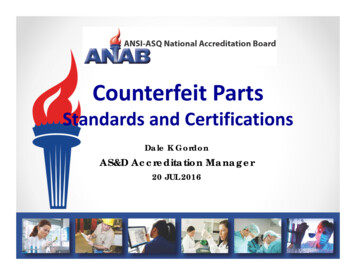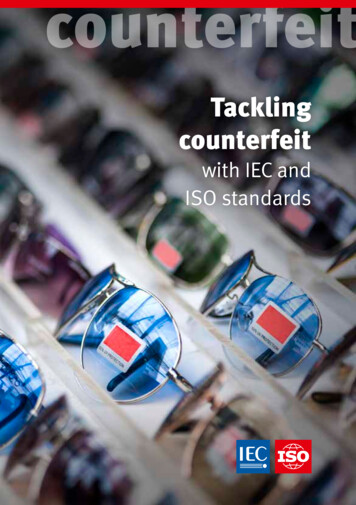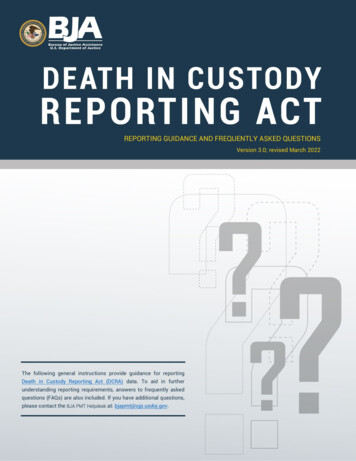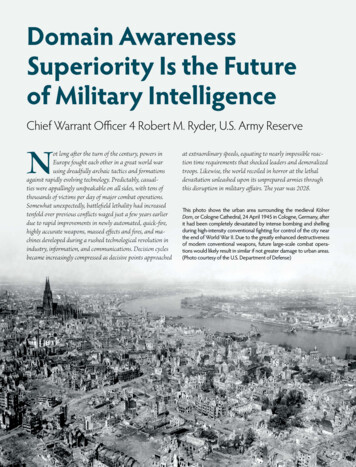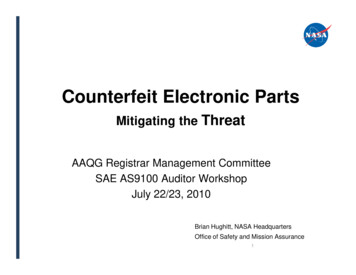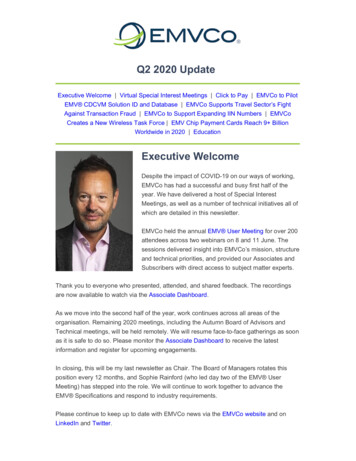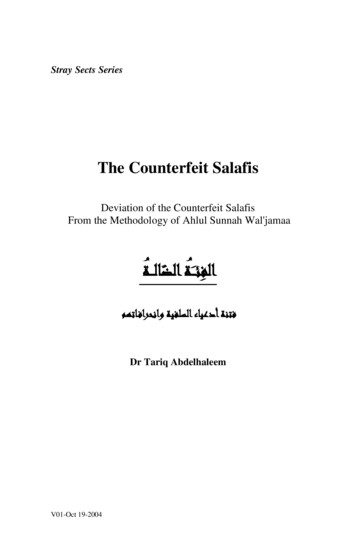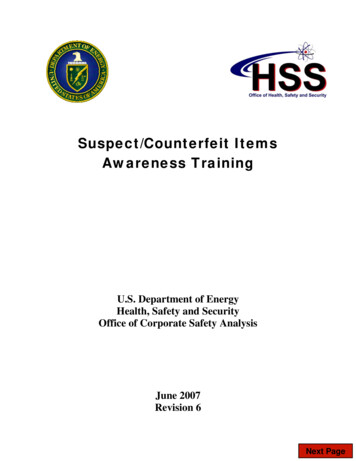
Transcription
Suspect/Counterfeit ItemsAwareness TrainingU.S. Department of EnergyHealth, Safety and SecurityOffice of Corporate Safety AnalysisJune 2007Revision 6Next Page
Suspect/Counterfeit Items TrainingSponsored by the Office of Corporate Safety Analysis (HS-30)DOE – HS Points of ContactCharles Lewis, Director, Office of Corporate Safety Programs (HS-31)19901 Germantown Road, Germantown, MD 20874charles.lewis@hq.doe.gov301-903-8008 (office), 301-903-1257 (fax)Tom Williams, Office of Analysis (HS-32)19901 Germantown Road, Germantown, MD 20874thomas.e.williams@hq.doe.gov301-903-4859 (office), 301-903-8403 (fax)Mark Petts, SCI Training Coordinator, Office of Analysis (HS-32)19901 Germantown Road, Germantown, MD 20874mark.petts@hq.doe.gov301-903-2414 (office), 301-903-8403 (fax)Subject Matter Expert and InstructorRoger Moerman, Technical Service Associates2535 W. 34th PlaceKennewick, WA 99337509- 585-7042 (office), 509-528-6771 (cell)rdm 2535@msn.comCopies of this booklet may be downloaded from the DOE HS-32 Suspect/Counterfeit-DefectiveItems website http://www.eh.doe.gov/sci along with other S/CI information.iiPrevious PageNext Page
DisclaimerThis training manual provides information on individual components identified as suspect orcounterfeit. Without additional information, the manufacturers or suppliers identified should notbe considered as to have engaged in any wrongdoing. It is not necessarily a negative reflectionon a supplier or manufacturer if their products are reported as Suspect/Counterfeit Items (S/CI).Reputable manufacturers and suppliers have a vital interest in preventing the manufacture anddistribution of S/CI associated with their names. The supplier or manufacturer may have beenvictimized and is pursuing S/CI associated with its products in an aggressive, prudent, andprofessional manner to get these items off the market. Therefore, each particular case must beexamined on its own merit without making premature conclusions about the fault or culpabilityof the manufacturer or supplier whose name is associated with the S/CI.AcknowledgmentThis training manual was developed with significant contributions by Roger Moerman,Technical Services Associates; Richard Green (DOE retired); and Lamar Palmer, MASConsultants.iiiPrevious PageNext Page
Table of ContentsPage1.0 INTRODUCTION . 12.0 DEFINITIONS. 43.0 DOE S/CI PROCESS. 54.0 DOE DIRECTIVES AND GIDEP. 65.0 DOE EH S/CI WEBSITE INFORMATION . 66.0 FASTENERS . 6APPENDIX A COMPONENTS AND PRODUCT INFORMATION . 15APPENDIX B SUSPECT INDICATIONS LIST. 17APPENDIX C SUSPECT/COUNTERFEIT ITEMS (S/CI) FOUND AT DOE FACILITIES. 25APPENDIX D REFERENCES. 59APPENDIX E RESOURCES . 60ivPrevious PageNext Page
1.0 INTRODUCTIONWhat does the fashion clothing, shoes and accessories industry have in common with the musicand movie industries, the antique furniture industry, the computer software industry, the cat foodindustry, the auto industry, the aircraft industry, the medical industry and the Department ofEnergy? All of these entities are plagued by counterfeit products. The purchase of one of the 40million bogus Swiss made watches sold each year around the world or counterfeited music ormovies is one thing, but what about the manufacture and sale of counterfeited cat food, drugs,automobile brakes, airplane parts or components and parts used in a nuclear safety system.When it comes to counterfeit goods, including industrial materials, items, and equipment, nomarket is immune. Manufacturers of counterfeits violate patents and copyrights, both forms ofintellectual property law. The effect of globalization has been that, if anything under the sun canbe patented, then anything under the sun can be knocked off at a profit. “Knockoff” parts are agrowing concern in industry: they are inferior in design and reliability. Knockoffs are similar tocounterfeit parts, but evade the patent and trademark laws by avoiding actual manufacturer /brand names. Knockoffs are reverse-engineered to look like the OEM products; oftenlabeled/marked with OEM part numbers, and the packaging is almost identical to the OEMdesign. For the purposes of the training, knockoffs will be categorized as suspect/counterfeititems.When counterfeit parts are used there is no traceability of quality or integrity and when a partfails there is no warranty to back it up – no liability is incurred. More importantly, counterfeitparts in a system can injure or kill when components and systems fail as a result of the use ofcounterfeit materials. The worst confirmed accident in the air from counterfeit parts occurred in1989 on a Convair 580 turboprop charter plane carrying 55 people from Oslo, Norway toHamburg, Germany. At 22,000 feet over the North Sea, the tail section of the craft beganvibrating violently and tore loose. The plane splattered over 3 miles of sea. Everyone aboarddied. Norwegian investigators painstakingly dredged up 90 percent of the 36-year old plane andfound the cause: bogus bolts, bushings and brackets. The charter company Partnair, went out ofbusiness, and the origin of the parts was never determined. (Lubbock Avalanche –Journal 1996)The Federal Aviation Administration estimates that 2 percent of the 26 million airplane partsinstalled each year are counterfeit, which equals approximately 520,000 parts. The June 10,1996 cover story in Business Week found that bogus airplane parts played a role in at least 166U.S. based incidents and malfunctions involving small aircraft during a 20-year period, 19731993.A World Health organization survey of uncovered counterfeiting cases involving legal drugs inthe early 1990s revealed that 51 percent the drugs involved carried no active ingredientwhatsoever. Another 17 percent contained the wrong ingredient, and an additional 11 percentcontained weaker than recommended concentrations of active medication. Some of these socalled ‘medications’ contained poisons capable of causing severe disability or death. Overallonly 4 percent of counterfeit drugs in the survey contained the same quantity and quality ofmedication as their authentic counterparts. One in ten medicines sold worldwide is counterfeit –fake – with no medical effect but generates about 32 billion dollars a year in sales for1Previous PageNext Page
counterfeit drug dealers. (Article -- Counterfeits Kill: Nurses Target Counterfeit Medicines,International Nurses Day, 12, May 2005)The U.S. Chamber of Commerce estimates that 750,000 American jobs have been lost tocounterfeiting and piracy. One small example: Eastman Machine Company in Buffalo, NewYork is a 4th generation family owned company started 1892 that has been producing top-of-theline cutting machines used in the garment industry. In the 1990s, criminal networks abroadcloned Eastman products and began churning out counterfeits. The name the counterfeiters usedwas ‘Westman.’ They stole the designs, model numbers and even the color of Eastman’spatented and trademarked products. The impact of these fakes was very real. Eastman salesdropped 50 percent. The workforce has diminished from 150 to less than g in auto parts is believed to be a 12 billion dollar a year business. Ford Motorsindicates that counterfeit Ford replacement parts are costing the company a billion dollars a year.General Motors, working with authorities, has conducted nearly 500 raids and broken up morethan 400 counterfeiting schemes since 1984. These raids resulted in seizing and destroying morethan 180 million dollars in potential fake parts.Substandard materials are known within DOE as suspect/counterfeit items (S/CI). They poseimmediate and potential threats to the safety of DOE and contractor workers, the public and theenvironment. Failure of a safety system due to an S/CI could also have security implications atthe DOE facilities. Fortunately, there have been no major accidents or any loss of life within thecomplex resulting from S/CIs. However, over the years S/CIs have entered the procurementsystem(s) at DOE sites. Left unidentified and uncorrected these items do present potential risks.A wide variety of counterfeit items have been identified and documented that include: Fasteners (bolts and bracketsRatchet straps/tie down strapsRefurbished molded-case circuit breakersTransformers, fuses, resisters, switch gearMetal strutsPipe components, fittings, flanges, valvesMaterial and testing certificationExamples of locations in which installed S/CI have been discovered include Cranes, elevators, and fork lifts: critical load paths;Vehicles: engines, brakes, or steering mechanisms;Aircraft: engines and attachments, wings, tails, and landing gear;Facilities: valves, compressors, and vessels used to contain radioactive fluids, hightemperature or high-pressure steam or fluids, or other hazardous material or safetysystems support safe operation or shutdown of a facility or processIn most cases, fraud is the cause of the problem. Some manufacturers have been known tomisrepresent their products and intentionally use inferior materials and processes to manufacture2Previous PageNext Page
substandard items, whose properties can significantly vary from established standards andspecifications. Companies or persons also alter markings to make materials appear to meetconsensus standards. Unfortunately, a high percentage of these activities originate from foreignsources, sometimes with the knowledge of U.S. importers. They are in fact defrauding thegovernment, industry and the public. Unfortunately, this problem continues to increase despitemeasures to detect and eliminate counterfeit, bogus, or unapproved items. In 1994,counterfeiting was estimated to be a 20 billion dollar business worldwide. By the year 2000, ithad expanded ten fold to a 200 billion dollar business. Accurately gauging the size of thecounterfeit market is impossible, but the World Customs Organization estimated the businesswas worth more than 500 billion in 2005, representing 7% of world trade. To compare it to alegitimate business at the time, “the counterfeit industry is twice as big as Wal-Mart.” (TimPhillips, Knockoff – The Deadly Trade in Counterfeit Goods, The true story of the world’s fastestgrowing crime wave, 2005)Various industries have conducted surveys and studies as an attempt to understand this problem.Reports from these studies recommend that programs be developed to help train employees toidentify suspect items and provide a process that encourages and promotes procurement,engineering, operations, maintenance, and inspection personnel to identify and eliminatesubstandard parts and materials. Removal of these parts and materials is the first step in theprocess. A system of prevention, established when all organizations are fully aware of theissues, must be implemented from the top down. Line management has to understand andendorse preventive measures. It takes the designer (who specifies the item), the buyer (whoprocures the item), the receiving inspector (who examines the item), the end user (who installsand operates the item), and the supplier (who supplies the item) communicating and workingtogether to identify and resolve these problems ---then we will see positive results.Allowing these unscrupulous business activities to take place is unacceptable. Detection ofcounterfeit, bogus, or unapproved products is possible, but identifying these items is every onesresponsibility with the assistance of qualified personnel to aid in making the final determination.3Previous PageNext Page
2.0 DEFINITIONSThe following definitions are used in the S/CI training and apply to this participant handout.Certified Material Test Report. A written and signed document that is approved by a qualifiedparty and contains data and information that attests to the actual properties of an item andcontains data and information that attests to the actual properties of an item and the actual resultsof all required tests.Counterfeit Item. A counterfeit item is a suspect item that is a copy or substitute without legalright or authority to do so or one whose materials, performance, or characteristics are knowinglymisrepresented by the vendor, supplier, distributor, or manufacturer. An item that does notconform to established requirements is not normally considered an S/CI if the nonconformityresults from one or more of the following conditions, which should be controlled by siteprocedures as nonconforming items: defects resulting from inadequate design or productionquality control; damage during shipping, handling, or storage; improper installation;deterioration during service; degradation during removal; failure resulting from aging ormisapplication; or other controllable causes. (Reference; 10 CFR 830.120; and DOE O 414.1C,Quality Assurance; DOE G 414.1-3 Suspect/Counterfeit Items Guide for Use with 10 CFR 830Subpart A, Quality Assurance Requirements).Critical Load Path. A structural component (e.g., a bolt) in a crane, hoist, transporter, or otherhandling or lifting equipment that bears the load being lifted or moved, and whose failure couldresult in an operation safety problem or an unacceptable risk of injury to workers or the public.Defective Item. A defective item or material is any item or material that does not meet thecommercial standard or procurement requirements as defined by catalogues, proposals,procurement specifications, design specifications, testing requirements, contacts or the like. Itdoes not include parts or services that fail or are otherwise found to be inadequate because ofrandom failures or errors within the accepted reliability level (Reference: DOE M 231.1-2,Occurrence Reporting and Processing of Operations Information, August 2003). Manufacturersgenerally notify their customers when defective items are identified through such mechanisms asrecall notices. Such notices may be directly sent to customers, or may appear in Federal agencyor industry.Nonconformance. A deficiency in characteristic, documentation, or procedure that renders thequality of an item or activity unacceptable or indeterminate.Suspect Item. A suspect item is one in which there is an indication by visual inspection, testingor other information that it may not conform to established Government – or industry –acceptedspecifications or national consensus standards. (Reference: 10 CFR 830.120; and DOE O414.1C, Quality Assurance; DOE G 414.1-3 Suspect/Counterfeit Items Guide for Use with 10CFR 830 Subpart A. Quality Assurance Requirements) Suspect items must be furtherinvestigated to determine whether they are counterfeit. When an item contains indications, butinsufficient evidence, of irregularities such as noncompliance with agreed-upon specifications inthe manufacturing process, it may be declared suspect.4Previous PageNext Page
3.0 DOE S/CI PROCESSThe Office of Health, Safety and Security has taken a corporate leadership role and isaccountable for ensuring the effective implementation of the Department’s S/CI process. Thisactivity was formerly performed by the Department complex-wide Quality Assurance WorkingGroup.Below is a graphic depiction of the S/CI Process DOE has developed to aid in identifyingsuspect/counterfeit and defective items.The S/CI process flow chart is included in the Office of the Environment, Safety and HealthProcess Guide for the Identification and Disposition of Suspect/Counterfeit Items at Departmentof Energy Facilities. The detailed Process Guide can be found on the Office of Corporate SafetyAnalysis Suspect/Counterfeit-Defective Items website at http://www.hss.energy.gov/csa/csp/sci/that includes S/CI-related information and links to other related websites.5Previous PageNext Page
4.0 DOE DIRECTIVES AND GIDEPCurrent and draft directives and accompanying guidance relevant to S/CI can be found athttp://www.directives.doe.gov. Also see Appendix D – References.Government-Industry Data Exchange Program (GIDEP)The GIDEP (Government-Industry Data Exchange Program) is a cooperative activity betweenGovernment and Industry participants seeking to reduce or eliminate expenditures of time andmoney by making maximum use of existing knowledge. The program provides a means toexchange certain types of technical data essential in the research, design, development,production and operational phases of the life cycle of systems and equipment. DOE participatesin GIDEP and is directed by Office of Management and Budget (OMB) letter 91-3 to report S/CIrelated events to GIDEP for posting on their website found at http://www.gidep.org. OMB letter91-3 can be found at http://www.hss.energy.gov/csa/csp/sci/ on the Office of CorporatePerformance Assessment website in the References area.5.0 DOE EH S/CI WEBSITE INFORMATIONThe Office of Corporate Safety Programs has developed, implemented, and maintains a websitefor relevant S/CI and defective item information and related reference documents athttp://www.hss.energy.gov/csa/csp/sci/. The lessons learned program also maintains a web sitefor relevant operating experience at http://www.hss.energy.gov/csa/analysis/ll/.6.0 FASTENERSSince the 18th century, valuable information on fastener design, testing, manufacture, andservice has been developed in such countries as the United States, United Kingdom, Germany,Holland, Austria, Japan, France, Belgium, Switzerland, and Italy. The time interval between theSecond World War and the close of the 1960s has been termed the "golden era" of fastenerdevelopment.Although counterfeit fasteners were first detected in the U.S. in early 1985, it is a common beliefthat manufacturing began in 1979-80 when the second major escalation of oil prices occurred.Japan is very sensitive to energy (oil) costs and saw a chance to reduce energy consumption byusing low-carbon, boron steel in bolt making.About half a century of progress in developing fastener standards in the U.S. has been centeredon the procedures of the American National Standards Institute, Inc., (ANSI) and the IndustrialFasteners Institute (IFI). The design engineers and managers of manufacturing and constructionindustries have consulted ANSI and IFI standards covering dimensions, geometry, and practicefor a great number of mechanical fasteners. Further detailed information is also available from6Previous PageNext Page
engineering and production handbooks and other governing agencies that have producednationally recognized fastener standards, including the American Society of Testing Materials(ASTM), the American Society of Mechanical Engineers (ASME), and the Society ofAutomotive Engineers (SAE).Note: The Dingell Report (U.S. House Subcommittee Report of July, 1988) indicates that theproblem may have started as early as 1974, but nothing is provided to substantiate the allegation.6.1 Counterfeit ExamplesBelow are some comparisons of some standard bolts that have been identified as beingcounterfeit items that are marked exactly the same as ASTM bolts. ASTM A449, Type ISAEJ429, Grade 5Headmarks on ASTM 449, Type 1 are identical to those on SAE J429, Grade 5. Grade 5 or 5.2bolts that do not meet specifications due to improper heat treatment could result in bolt failure –usually a brittle failure from excessive hardness. ASTM A354, Grade BDSAE J429Grade 8 head marks on A354; Grade BD is identical to SAE J429 Grade 8. Grade 8.2 bolts relaxwhen subjected to temperatures greater than 500 degrees F as a result of chemistry and heattreatment methods, which differ from Grade 8.IFI has data to show that bolts sold and marked, as Grade 8 may not even meet Grade 8.2requirements. Manufacturers may not have had adequate controls on the heat treatment processwhich can result in bolts being too hard-high ultimate tensile strength (UTS), but brittle. TheGrade 8 bolts may fail in high-stress applications at normal temperatures.For additional information on bolt head markings based on the grade of the fastener, seeAppendix III to ANSI B18.2.1. Copy of Appendix III is shown on the next page.7Previous PageNext Page
8Previous PageNext Page
6.2 IdentificationFasteners are not the only parts that are subject to counterfeiting. The list of components thathave been identified to have been misrepresented, altered, counterfeited, used sold as new isgrowing every year. The best way to inform people of the problems is to provide a broad base ofinformation from as many sources as possible for their review.This section is a compilation of information from a number of sources such as the Department OfEnergy, the National Board of Boiler and Pressure Vessel inspectors, and the Nuclear RegulatoryCommission bulletins. The information covers material from a head mark list (next page) derivedfrom customs investigations, to components and products that may be vulnerable tocounterfeiting, to counterfeit detection traits, documentation detection traits, and contributingcauses for receipt of these type materials.In 1990 Public Law 101-592, 101st Congress “Fastener Quality Act” (FQA) was enacted. TheAct is intended “To require that certain fasteners sold in commerce conform to the specificationsto which they are represented to be manufactured, to provide for accreditation of laboratoriesengaged in fastener testing, to require inspection, testing, and certification, in accordance withstandardized methods, of fasteners used in critical applications to increase fastener quality andreduce the danger of fastener failure and for other purposes.”6.3 Major AmendmentsThe FQA has been amended several times since 1990; the major amendments are summarizedbelow. According to the National Institute of Standards and Technology (NIST), U.S.Department of Commerce, the FQA signed by President Clinton on June 8, 1999 is “morefocused and less burdensome.” The amendments include: Eliminated Requirements: The amended law no longer requires NIST to approveorganizations that accredit fastener testing laboratories. Covered Fasteners and Quality Assurance Systems: Fasteners covered under the FQA aredefined as limited to bolts, nuts, screws and studs (having a nominal diameter of 6miilimeters/0.25 inch or greater), or direct tension- indicating washers that are throughhardened) or meet a consensus standard that calls for through-hardening) andmanufactured to standards and specification of consensus-standards organizations orgovernment agencies that require a grade mark.Many fasteners are exempt from coverage, including those that are:1. Part of an assembly2. Ordered for use as a spare, substitute, service, or replacement part, unless that part is in apackage containing more than 75 of any such part at the time of sale or is contained in anassembly kit3. Produced and marked as ASTM-A 307 Grade A4. Produced in accordance with the ASTM-F 432 standard9Previous PageNext Page
5. Specifically manufactured for an aircraft if the quality is approved by the FederalAviation Administration or by a foreign airworthiness authority6. Manufactured in accordance with International Organization for Standardization (ISO)9000, 9001, 9002, or TS16949; Quality System (QS) 9000; or other fastener qualityassurance system defined by the law, or7. Manufactured to a proprietary standard.To encourage the use of quality management systems such as QS 9000, fasteners are exemptfrom the FQA if they are manufactured in a facility using such a system.If an accreditation organization chooses not to follow ISO guidelines for registration andaccreditation, they may submit documents to the NIST director that establish their ownguidance/requirements for (1) accredited bodies to register manufacturing systems as meetingFQA quality assurance requirements, (2) accreditation of testing laboratories, and (3)approval of accreditation bodies to accredit testing labs. Reduced Paperwork: To reduce paperwork record-keeping burdens, companies areallowed to transmit and store electronically all records on fastener quality providedthere are reasonable means of authentication of the source of the document andreasonable protection against alteration. The record required for a covered fastenerwill be the record of conformance that identifies the fastener by description, lotnumber, and the manufacturer, and includes other information defined by the law. Hotline (1-800-424-2980): To combat the manufacture, sales, or distribution offasteners that are fraudulent under the FQA, the Commerce Department hasestablished and maintains a hotline for reporting alleged violations of the laws. Allcredible allegations are forwarded to the Attorney General.NIST maintains an FQA Web site (www.nist.gov/fqa) that includes the text of the amendedFQA and the text of a February 1999 Commerce Department study of the law. The site alsocontains procedures for implementing the FQA, a list of self-declared accreditation bodies,lists of accredited laboratories, and the fastener insignia register and recordal of the U.S.Patent and Trademark Office.The Suspect/Counterfeit Headmark List is shown on the following page. All headmarks onthis list are to be considered suspect/counterfeit and require no further testing.The S/CI Headmark List is still relevant and bolts received need to be compared to the list.One example that brings this message home occurred in April, 2003. Lawrence LivermoreNational Laboratory received a shipment of bolts in from their approved bolt supplier. Arandom check of the bolts discovered a number of “KS” headmark bolts mixed in with othergood bolts. The irony of this situation is that Kosaka Kogyo, manufacturer of “KS” boltswent out of business over 10 years earlier.10Previous PageNext Page
SUSPECT/COUNTERFEIT HEADMARK LIST11Previous PageNext Page
6.4 Stainless Steel FastenersIn November 1993, the IFI issued a Fastener Advisory regarding 18-8 stainless steel bolts.The advisory warned about a “bait and switch” tactic in which a distributor takes an 18-8 bolt(indicated by two radial lines 90 degrees apart), but no manufacturer’s marking, and sellsthem as ASTM A320 Grade B8 bolts after hand-stamping B8 on the heads.As a result of this IFI Advisory, DOE sites conducted a search of facility stores for stainlesssteel fasteners with hand-stamped B8 grade marks. Hundreds of stainless steel bolts withhand stamped B8 grade markings, along with a variety of other raised and depressed headand manufacturer’s markings were identified in facility stores throughout the DOE complex.An inspection of shop stock at a Hanford Site facility revealed bolts with three differentraised grade marking, 18-8, 304, and F593C, along with raised manufacturers’ identificationsof DK, H, HP, C, SO, CS, PMC, TH, THE, and a STAR. The majority of the remainingsamples found at Hanford exhibited raised grade markings of 18-8 and 304, with a B8 grademarking and manufacturer’s identification hand-stamped into the head of the bolt.Finally, a few samples did not display any manufacturer’s markings. Most of the boltsdiscovered were purchased with the specification to meet a national consensus standard,American Society for Testing and Materials (ASTM) A193, B8 Class 1 rather than theASTM A320 standard discussed in the IFI warning.The Savannah River Site also conducted a site-wide search of facility stores with similarresults. A total of 159 stainless steel fasteners with hand-stamped B8 grade marks and raisedor hand-stamped manufacturer’s symbols were found. Fifteen stainless steel fasteners thathad no manufacturer’s symbol were also found.The requirements of the ASTM A193 standard regarding fastener marking and certificationare very similar to those required by the ASTM A320 standard discussed in the IFI Advisory.The ASTM A193 standard requires that grade and manufacturer’s identification symbols beapplied to the heads of bolts that are larger than ¼” in diameter. The standard, however, doesnot specifically differentiate between raised and depressed head markings, but states onlythat “for the purposes of identification marking, the manufacturer is considered theorganization that certifies that the fastener was manufactured, sampled, tested, inspected inaccordance with this specification.” In other words, the standard allows for some of therequired marking to be formed into the head of the bolt (either raised or lowered) duringmanufacturing, and the rest to be applied later on via hand-stamping.Since ASTM A193 does not differentiate between raised and depressed marking, thesefasteners can be counterfeited in the same way as the ASTM A320 fasteners discussed in theNovember 1993 IFI warning. For example, distributors can procure 18-8 stainless steel boltsthat were manufactured by anonymous party, and without conducting the necessaryupgrading process or certification testing, a second party could hand-stamp B8 and a12Previous PageNext Page
manufacturer’s marking into the heads to indicate that the fasteners exhibit the mechanicaland chemical properties required of ASTM A193 Grade B8 Class 1.A listing of suspect stainless steel fastener head marks is shown on t
the DOE facilities. Fortunately, there have been no major accidents or any loss of life within the complex resulting from S/CIs. However, over the years S/CIs have entered the procurement system(s) at DOE sites. Left unidentified and uncorrected these items do present potential risks.
